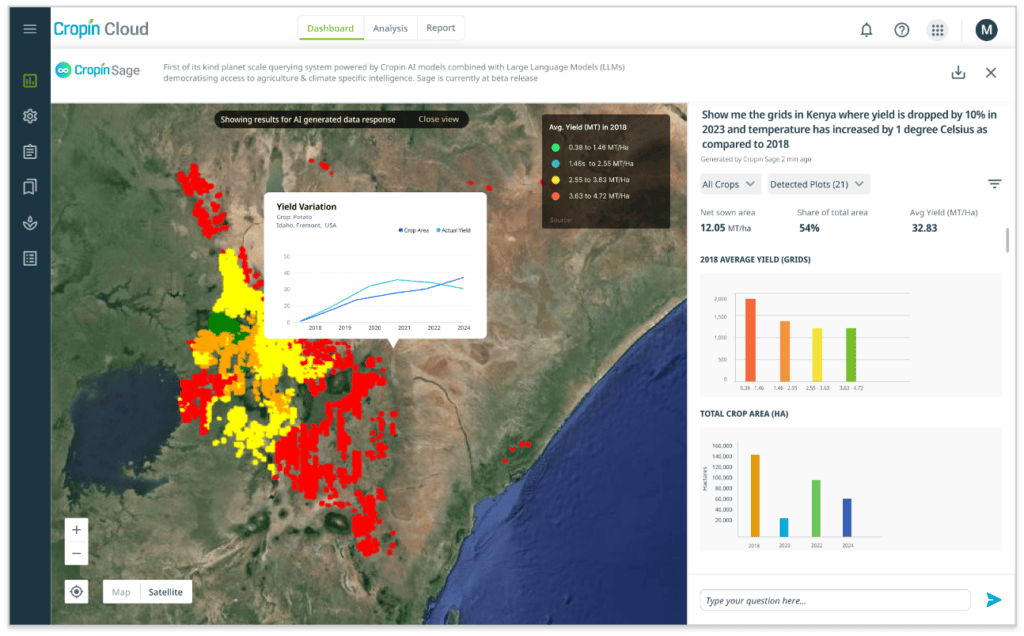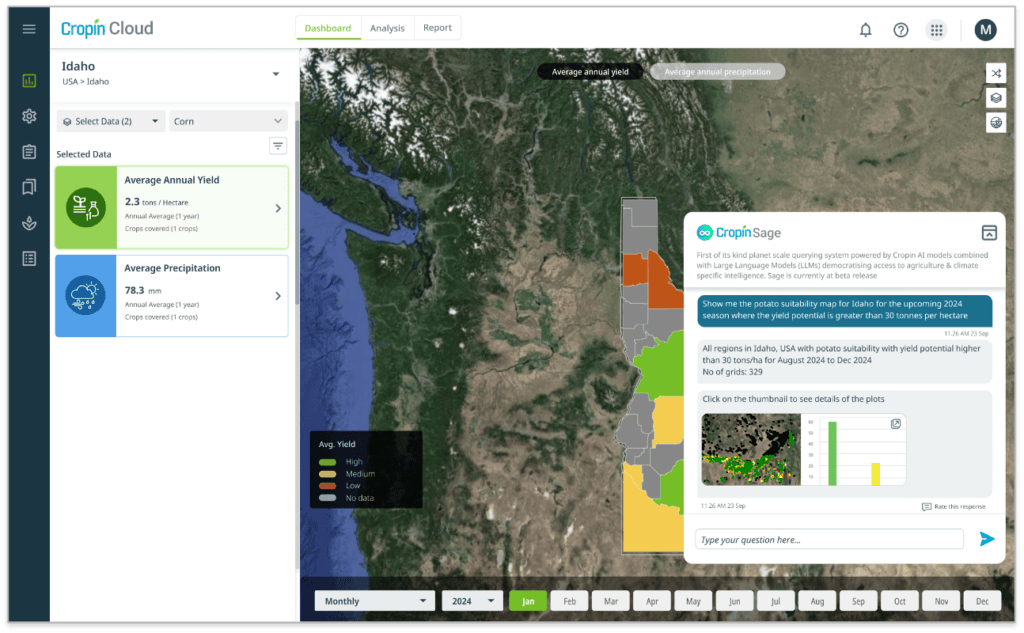GenAI powerd platform Sage predicts crop yields globally

Cropin Technology has launched Sage, an innovative Generative AI-driven platform that predicts crop yields worldwide in real-time. Leveraging advanced technologies like Google Gemini, Sage provides precise, scalable data to help agribusinesses make informed decisions about cultivation practices, irrigation, climate, and soil. Future Farming asked Krishna Kumar, CEO of Cropin, about what Sage will mean for farmers.
On July 17, 2024, Bengaluru-based Cropin Technology announced the launch of Sage, an advanced agri-intelligence solution. Sage divides the world’s agricultural land into grids of 3×3 meters, 10×10 meters, or 5×5 kilometers, enabling the delivery of accurate data at unprecedented speeds. This helps various stakeholders, including CPG players, seed manufacturers, food processors, and governments, make well-informed decisions about crop cultivation, irrigation, climate, and soil conditions, according to Cropin’s CEO Krishna Kumar.

“Cropin Sage, the world’s first Gen AI-powered agri-intelligence platform, is indeed a pioneering solution in the agricultural sector. It stands out from other platforms due to its comprehensive and integrated approach. Here are some key differences:
- Global Crop Knowledge Graph: Cropin Sage is built on a vast, proprietary global crop knowledge graph that spans over 500 crops and 10,000 crop varieties across 92 countries. This extensive database provides unparalleled insights and predictions across the agricultural value chain.
- Contextual Deep-Learning AI Models: Cropin Sage employs 22 contextual deep-learning AI models that deliver actionable insights on crop detection, yield estimation, irrigation scheduling, pest and disease prediction, and more. These models are field-tested and deployed by over 250 public and private sector enterprises worldwide.
- Integration with Satellite Imagery: Cropin Sage leverages satellite imagery to provide accurate and scalable insights, making it accessible to farmers and agribusinesses globally. This approach eliminates the need for expensive hardware and infrastructure, making it more inclusive and cost-effective.
- Predictive Intelligence: Cropin Sage’s AI models provide predictive insights on crop yields, climate patterns, and soil conditions, enabling stakeholders to make informed decisions and mitigate risks. This predictive capability sets it apart from other platforms that may focus more on historical data analysis.
- Scalability and Security: Cropin Sage is built on Google Gemini and Google Cloud, ensuring a scalable and secure platform that can handle large volumes of data and support the needs of diverse stakeholders, from farmers to governments and financial institutions.
- Comprehensive Data Layers: Cropin Sage supports a wide range of datasets, including crop intelligence, weather and climate indices, earth observation data, advanced crop models, and socio-economic data. This comprehensive approach provides a holistic view of the agricultural landscape.”

“Agricultural data is highly complex, coming from various sources and factors influencing the cultivation process. The way potatoes are grown in Africa is completely different from how they are grown in the UK. Similarly, all crops have unique management practices and cultivation strategies that depend on the region. We cannot apply our learnings on cocoa cultivation in Africa to Brazil. Each region is different.
The key reason for using a grid-based mapping system is for enabling granular data visualisation and ease of use for decision-making. For example, an agri-business cultivating grapes in the UK would be more interested in understanding the ground-level data specific to their region. By representing the data with graphs and charts that show the region where they cultivate their crop, it becomes easier to understand and use for business decision-making.
Here is how it works: when an enterprise customer signs up for Sage deployment in a specific region, Sage provides all the relevant information, such as climate data, yield, irrigation, and soil conditions, in a grid format for that specific region. We aim to democratise the use of AI in food systems, and the best way to do this is by offering easy-to-use and user-friendly tools. By overlaying all the information on their regional grid/map, we ensure the data is represented in the most accessible way possible.”
“Predicting crop yields is historically a formidable challenge for the industry due to the complexities of soil health, weather conditions, pest and disease management, and cultivation practices. Traditional methods of crop yield predictability, once deemed sufficient, no longer account for today’s complexities. Climate change has introduced a multitude of variables, making the task even more challenging. Unpredictable weather patterns, extreme events, altered growing seasons, and evolving pest pressures all contribute to the delicate balance between sowing and reaping.
Accurate yield predictability requires scientific expertise and local knowledge about the region and crops grown there. It involves diverse data sets, including weather patterns, seed genetics, soil properties, farm management, and statistical data. We employ a field-tested multi-tier algorithm to compute yield estimates. Our AI models and Gen AI capabilities enhance the accuracy of this process. Our proprietary yield prediction models at a plot-level, used by customers worldwide, achieve 80-90% accuracy most of the time.
Cropin Sage seamlessly navigates a vast universe of proprietary and public datasets, linking grids and crops from around the world, integrating and analysing them to deliver comprehensive insights. In this sense, Sage is a cutting-edge innovation for agri-food businesses struggling to manage demand-supply dynamics and price sensitivities.”
“Firstly, I would like to clarify that Sage is an enterprise platform. Currently, we do not intend to sell this directly to growers, but they are the end beneficiaries. This is not just a knowledge-sharing platform but one that accelerates decision-making based on real data sources from the field, including satellite monitoring, weather channels, and Cropin’s own crop models.
For an enterprise customer, consider the chocolate crisis or the recent crisis faced by the orange juice industry. These crises did not happen overnight but resulted from multiple factors over time. In the case of the chocolate industry, the main issue was the diminished cocoa yield from the West African region, which contributes over 60-70% of the world’s cocoa supply. When an enterprise customer deploys Sage, they get comprehensive information related to the production patterns and yields of specific crops. Knowing that production will be impacted in a certain region for a certain season allows businesses to create robust plans to source the next season’s crops.”
“The majority of our data comes from satellite monitoring and sources such as weather data. However, we verify it with field data collected from farmers and field officers. When deploying solutions at a country or regional scale, we cannot rely entirely on ground data. Therefore, our major data sources are geo-tagged satellite data, sensors, and weather channels.”
“At launch, Cropin’s enterprise customers can deploy Sage across various geographic locations, providing intelligence on 13 key crops: corn, paddy, soy, wheat, onion, potato, sugarcane, cocoa, coffee, cotton, canola, grapes, and strawberry. These crops collectively cover almost 80% of the world’s food demand. We aim to build and deploy Sage globally in a phased approach, aligned with enterprise customer requirements and demand. As we move forward, we will add more crops to Sage’s application and architecture.”
“We have numerous internal and third-party studies demonstrating the impact of Cropin’s digital and predictive intelligence solutions in improving productivity, yield, and farmer efficiency. Sage, however, is a new product capability within the Cropin Cloud platform. While we have conducted pilot projects with a few customers, large-scale commercial deployment is currently in the activation process.”
“Since deploying our solutions in 103 countries, we adhere strictly to the regulations of each specific region. We understand the sensitivities of individual data and rigorously follow all global standards for data collection and sharing. Our data is secured with the enterprise customer for whom we deploy the specific solution, and we do not share or sell farmer-specific data.”